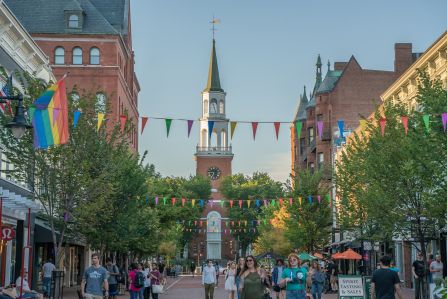Getting to Net Zero:
a municipal outlook


Ideas and Best Practices from Both Sides of the Atlantic
05 May 2022
On 28 April the Transatlantic Climate Bridge organized a discussion with climate policy officials from Heidelberg, Germany and Burlington, Vermont, USA. The two representatives discussed their successes and challenges in reaching ambitious net-zero targets. What can we learn from their work and how easily can their successes be transposed to other municipalities in TCB countries?
On 28 April the EU Commission announced the 100 EU cities that will participate in the mission to be climate neutral by 2030. An ambitious goal, extending well beyond the Union’s own targets. Commission President von der Leyen noted the need for trailblazers to pave the way for the rest. Among those hundred is Heidelberg who, later that afternoon in a TCB event together with Burlington, Vermont discussed its journey towards net zero emissions. This serendipitously-timed discussion centered on the role of citizen participation in reaching net-zero targets. What became clear is that getting to net zero doesn’t happen without a few bumps in the road and is largely dependent on factors beyond a municipality’s control. So what lessons can we learn from Heidelberg and Burlington’s experiences, and how applicable are they to others?
What does net zero actually mean?
Net zero refers to when the net amount of greenhouse gas emissions being emitted into the atmosphere is zero. “Net” means that there still may be some emissions, but that they are then balanced by negative emissions, such as, for example, removals (e.g., carbon capture technology) or carbon sinks (sequestration via e.g., forests). Between the positive and negative emissions, there are “net zero” in total. Net zero targets are gaining prominence on the national and subnational levels as actors step up their ambitions in order to maintain the Paris Agreement goal of limiting warming to 1.5 degrees Celsius.
Most net zero targets to date have been set for 2050, but Burlington and Heidelberg have more ambitious timelines. Burlington has a net zero energy goal for 2030 and Heidelberg, as of the announcement of its participation in the EU program, is now also striving for net zero by 2030. These cities will test the waters of what is possible, serving as a lighthouse of lessons learned for the necessary transformations on which, sooner or later, the rest of the world will also embark.
Challenges and opportunities for municipalities
The challenges for municipalities are a microcosm of what countries face. To enumerate them all here would exceed word limits and attention spans. We’ll therefore highlight just some of the considerations cities and municipalities face and draw from selected examples Heidelberg and Burlington provided in the discussion.
Electricity
As a municipality or any governmental entity, the extent to which a net zero transition is possible depends on the reach of the policy levers at one’s disposal. For decarbonizing electricity this will depend on the cost of the electricity-generating resources available. For Burlington, having access to cheap and accessible hydropower in addition to some wind and solar resources enabled them to source 100% of their electricity renewably. The last piece of the puzzle is the process of shifting their peaker plant to biofuels, truly making them fossil fuel-free.
This ambitious approach is enabled by Burlington owning their local utility company (Burlington Electric Department - BED), allowing them to pursue electricity policies that align with their climate-political strategies. In a municipal context where there is less control over local electricity production, or where policies are fundamentally decided at the national level, reaching net zero targets will require coordination on the national level. The municipality itself, i.e., the collection of public building stock that makes up the institutional part of the municipality, can always strive for net zero electricity usage with the construction of local resources, e.g., solar and wind that can net account for local usage.
Transport
Another challenge faced by both Heidelberg, Burlington, and most, if not all, municipalities is the transition to net zero transport. Heidelberg, a student town with strong public transport resources and public support for climate policy, boasts 70% of its population using carbon free multimodal transport, e.g., bike, train, tram and bus, and by foot. Reaching the last 30% presents its challenges with commuters coming to work in the city and locals who still want to have car access. To reach this final margin Heidelberg has brought out both the carrot and the stick in, for example, providing subsidies for electric vehicles and electric bikes and reducing the amount of parking spots available in the city.
The carrot approach can be immensely costly for a city if designed in a way to present equal opportunity to all income classes, and Heidelberg’s stick approach was also met with resistance. Like any climate policy, whether municipal or national there will always be a trade-off between the costs imposed and was deemed politically acceptable. Heidelberg, even in pairing the reduction of parking spots with an expansion of public transport, faced considerable opposition from locals who thereafter found it near impossible to put their car (which for them is a sunk cost) somewhere when they came back from work at night.
Buildings and heating
The building/heating sector, which along with transport is viewed as notoriously hard to decarbonize, needs retrofits of traditional heating sources and ailing efficiency infrastructure. For adjusting traditional heating infrastructure Burlington has subsidy schemes for retrofitting houses with heat pumps. The uptake has been successful, but they have found that the pumps are most often used in what they described as “shoulder season” i.e., in late spring, summer, and early fall to run air conditioning. People, despite having a heat pump, use their existing gas lines for heat as the price of natural gas is comparatively less. Their challenge now is to convince people to sever these lines and rely only on the pumps for both heating and cooling in spite of the costs.
Another challenge is that subsidies are often only attractive to people who own their properties. In order to reach renters, the city implemented benchmarked requirements for property owners to lower their energy usage to ensure efficiency targets happen across the board.
Retrofitting historic buildings is another hurdle both Heidelberg and Burlington face as historic towns. An innovative approach the BED has pursued in this regard is they put the historic buildings department in the lead for figuring out how to solve this problem. The ownership of the challenge has served as a better catalyzer than any prescribed rules and regulations could have wished for.
Financing it all
Financing climate action, especially for cash-strapped municipalities, is the key question at the heart of any discussion around ambition. Both Heidelberg and Burlington here, too, deliver innovative policies for enabling climate action in the face of financial bottlenecks. Heidelberg together with the local utility has set up a scheme to lease your roof space for solar panels. This lets those with minimal resources participate in the energy transition with little risk or upfront contribution needed. Moving from the individual to the municipal-level, Burlington has issued a voter-approved $20 million net-zero energy bond to finance some more capex-heavy activities like renewing the local electrical grid, financing the aforementioned peaker plant, and also for more subsidies.
Beyond what Heidelberg and Burlington are doing there are many financial schemes that can be pursued such as energy performance contracts to finance further retrofits with little upfront investment. Oftentimes refurbishments, energy efficiency improvements, changes to local supply of electricity or heat, will pay for themselves and more in the long-run (especially if national policies such as carbon pricing can help guide the price-signal for CO2-friendlier technologies), but the initial investment may simply lie beyond the reach of the resources of many municipalities.
Outlook
So what’s next for Burlington, Heidelberg, and the other 99 European cities now gunning for net zero by 2030? This will depend on not only what the cities want, but also what is financially feasible and politically implementable. You need the public on board and you need the staff and the resources to do it. Heidelberg and Burlington have made many steps in the right direction, from Heidelberg’s extensive history of public consultations and local involvement in climate policy planning to Burlington’s citizen engagement strategies and its Net Zero Energy Podcast. And, importantly, both cities have aligned their public coffers with their climate intentions.
Whether the hard-to-abate sectors will budge in the next eight years is yet to be seen, but the lessons to emerge from their ambitious goal will go a long way to informing the rest of us.

